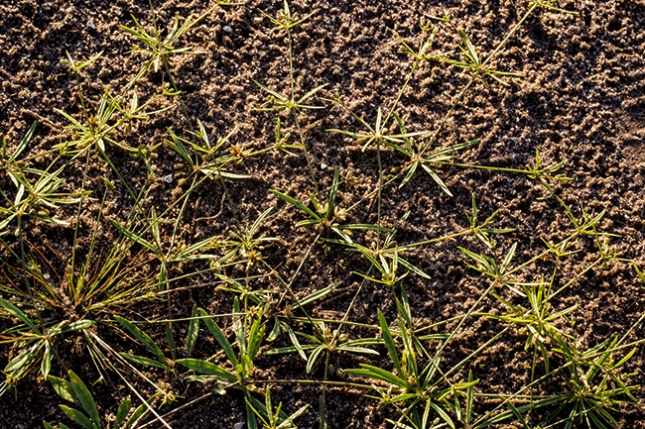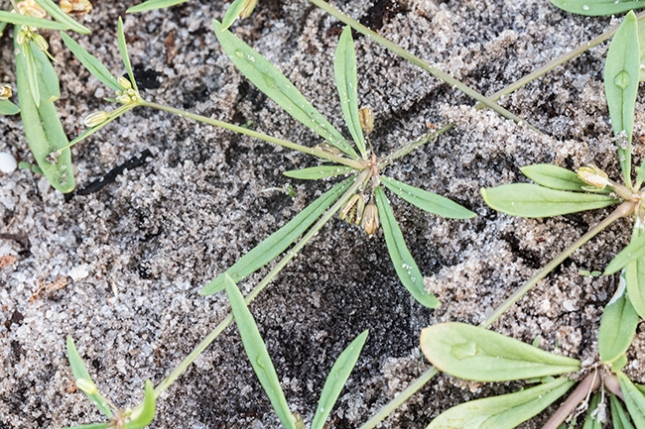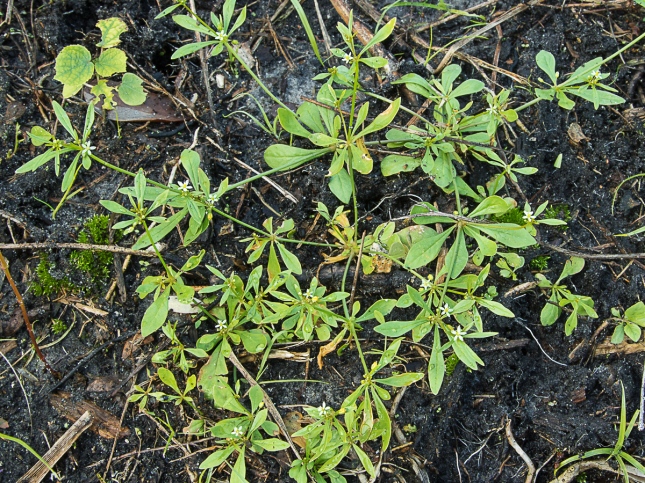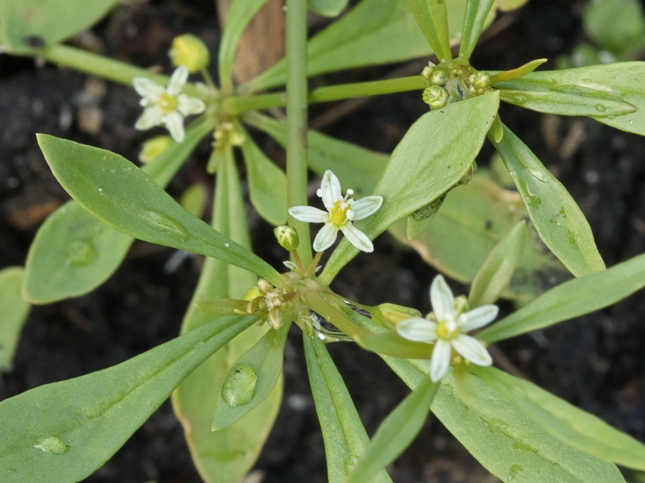Mollugo verticillata
(Mollugo is an old name from a similar plant, verticillata refers to the whorled leaves.)
Molluginaceae
No matter where you live, you see this unpretentious yet storied species. It grows everywhere, and I do mean everywhere, covering most of North America and much of the rest of the world. How and when it achieved global domination is an interesting question we’ll fail to answer momentarily.
Carpetweed is one of many mat-forming ground-hugging plants often found sprawled in each others’ company in hot, exposed, periodically dry places.

Reach out and expand, creating colonies all the way.
What’s so great about hugging the earth? Although it may go without saying, botanist John Fogg said it nicely in 1945, “the species can grow laterally, covering the ground with the carpet of its own foliage, and has a distinct advantage over its competitors, for the shade thus created reduces evaporation of moisture from the surface of the soil.” Self-mulching. Most of a plant’s water loss is from the bottoms of its leaves, but leaves on their bellies lie beneath the drying wind, not losing much water, and the water they do transpire recycles into the root zone.

Having transpiration blocked may inhibit cooling, which might explain why mat formers tend toward small leaves amenable to air cooling.
I’ve read that carpetweed seeds can germinate upon one rain event, completing their brief life cycle from seeds to new seeds in a few weeks with no second rain. A one-rain wonder, although this needs verification.
 Now for the distribution. Checking the plant manuals at my elbow, here is what I find:
Now for the distribution. Checking the plant manuals at my elbow, here is what I find:
“Native to Tropical America”
“Native to Tropical North America and South America”
“Native of Tropical America”
“Introduced from Tropical America”
You get the picture, and we see why facile statements of nativity may be too simplistic. If carpetweed originated in Tropical America, it sure has done a fine job spreading, now in almost every state of the U.S., much of Canada, Africa, Eurasia, and Asia. We might say, okay fine, humanity tracked it all over the place with planes, trains, and automobiles. But a complication may pull the rug out from under that easy view.
Botanist Jefferson Chapman and collaborators in 1974 reported charred carpetweed seeds 3000 years old in archaeological remains near Knoxville, Tennessee. Sadly, the site is now under pontoon boats on Lake Tellico. Seeds of the same species also turned up in Troyville, Louisiana archaeological remains from merely 1500 years ago.

Now go figure. We must answer the unanswerable questions.
- If the species is native to Tropical America how did it journey 3000 years ago to Tennessee? There was limited and poorly documented ancient commerce between points in the American Tropics and the mainland, so arriving with people is possible. Florida is home to other probably non-native pre-European “natives,” such as papayas, agaves, and peppers. On the other hand, the minute seeds could ride a bird or a storm.
- Why were the seeds at a human settlement? They were charred, that is, in ancient campfires. Was somebody cooking carpetweed? Unlikely, given the sparse seed production and the low food value of the foliage, although possible. More likely, it was a weed in whatever better crop was on the menu, which by the way, predated the arrival of corn and beans.
You have to use your own imagination, drifting back mentally to Tennessee three millennia ago. What it must have been like. Commerce with other peoples, although the extent not known. Agriculture occurring, with its attendant weeds. My imagination says carpetweed is a human-loving camp-follower, where people go, it goes, and has been up to that trick for a long time whether or not it fully truly is “native to tropical America.” Could it have been a scattered and very old agricultural weed distributed from Tennessee and Louisiana to settlement-to-settlement over a large geographic area? Sure why not.
There is another mystery, the one most studied. Avoiding a boring lesson in plant physiology, let it be said that there are two main photosynthetic systems in the plant world. Plants of cool and temperate climates tend toward “C3” photosynthesis. By contrast, many from hot sunny climates have “C4” photosynthesis, which offers protections from heat and light. Guess what, carpetweed is neither fish nor fowl, having aspects of both photosynthetic systems. Such intermediacy occurs in other unrelated plants as well, not associated with any known habitat or circumstance. That being true, I’m only guessing, but is the tropical/nontropical C3/C4 fence straddling coupled with that quickie annual life cycle the secret to carpeting the earth from “native to the Tropical America” to frosty Canada?
Uncle Tree
July 7, 2018 at 10:08 am
From sea to shining sea smacks of “smart”, whatever the contemporary device may be.
Andrew S. Krantz
August 2, 2019 at 3:26 am
I found several small bunches in my garden. I thought they were pretty, so I potted them. I wonder how they would do inside?
George Rogers
August 19, 2019 at 8:15 pm
Would love to know. I can’t even guess. Tough species, but plants have a mind of their own. Might demand a lot of light?